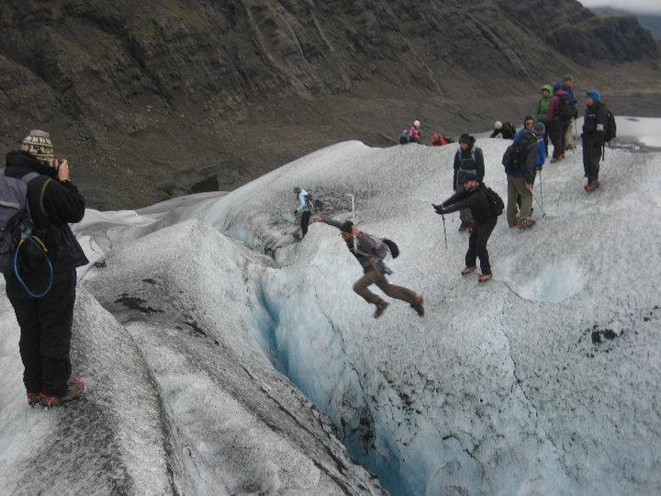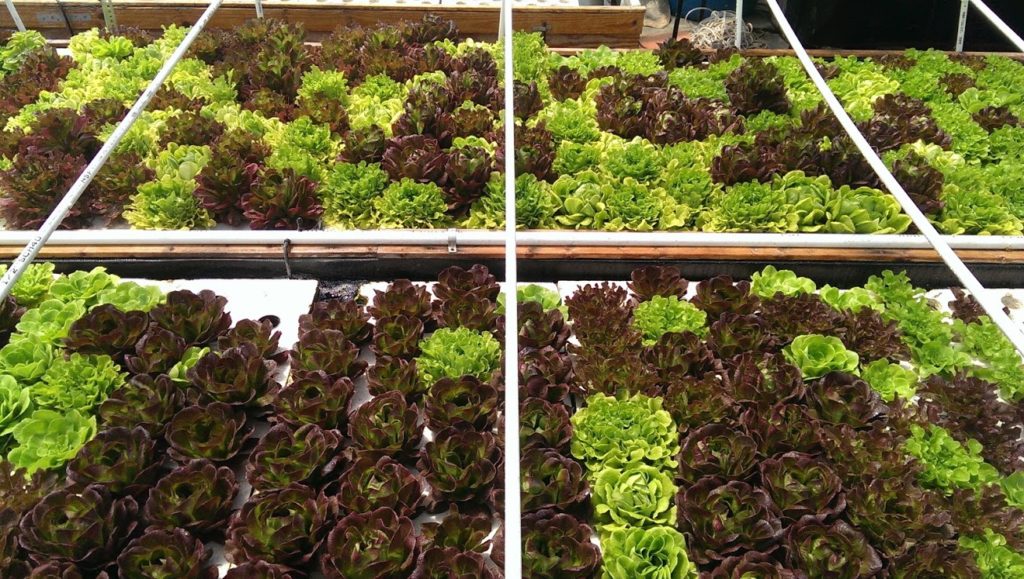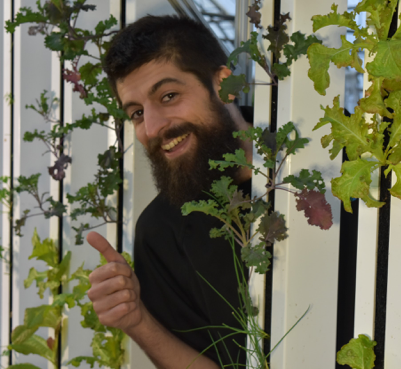From architecture to volcanology to environmental geology, with some of his favorite Chicken Lou’s sandwiches in between, Northeastern alumnus Andrew Ingalls would not be where he is today without his co-ops, friendships, and experiences at Northeastern.
As the chief operating officer (COO), head research developer, engineer, and financial manager of Trifecta Ecosystems in Meriden, Connecticut, Ingalls has a full plate, but comes to work every day with a smile on his face. Trifecta Ecosystems is an aquaponics company started by friend and Northeastern alumnus Kieran Foran that works to shift the current food paradigm towards controlled environment agricultural (CEA) technologies, like aquaponic systems, and educates the public on how to grow food in an urban environment.
But let’s take it back to Ingalls’ beginnings at Northeastern, long before he knew anything about aquaponics and CEA farming.
The undergrad years
After entering Northeastern as an architecture major, and quickly growing to dislike it, Ingalls switched to environmental science with a concentration in geology.
He had many opportunities through co-op and travel that led him to find his career passions.
As a co-op student at the US Geological Survey in Northborough, MA, Ingalls assisted in completing fieldwork studying ground contaminants in well fields on Cape Cod. He was able to be part of data collection, analysis, and even presentations.
“It was great to see projects from start to finish and be able to do a lot of the real work, even just as a co-op,” Ingalls said.
But it was his study abroad experience in Iceland that solidified his passions in hydrogeology and volcanology, and inspired him to continue studying these fields in graduate school.
In the summer of 2010, Andrew Ingalls participated in this study abroad with the geology department. They spent a month backpacking through Iceland to study different geological features, and were even able to see fresh lava fields as a result of a large eruption that occurred right before their trip was scheduled to leave.

Exploring Iceland. Courtesy Photo.
“Getting to see this power stored in the earth that comes out so violently, but also create things – it was just a really beautiful moment,” he said. “That was the moment for me where I knew I wanted to go to grad school and study volcanology.”
This trip still makes the list of one of the best things he’s done in his life so far, and it helped him to meet his graduate mentor which set things in action for life after Northeastern.
The graduate years
After meeting a professor of volcanology from Kansas State University, and traveling out to Nevada with him to explore what his fieldwork would be like, Ingalls enrolled in the graduate program in volcanology at KSU.
While there, most of his research took him to the northeast corner of Nevada, up to parts of Yellowstone. His work revolved around rhyolites, volcanic rocks that were thought to be from large hotspot deposits across the region. Ingalls spent much of his time comparing the rhyolites to other extensional volcanic rocks in the area, as well as Yellowstone hotspot volcanic rocks. Each type of rock had a distinct chemical composition, distinguishing how they were formed.
Moving on
After graduation, Ingalls found his first job as an environmental geologist at Golder Associates in Manchester, New Hampshire. He had many opportunities to work on a variety of projects first focusing on field work, before moving towards data analysis of field results.
While at Golder, Ingalls began to pick up some additional work, writing grants for his friends that were starting an aquaponics company. Soon, he became very immersed in everything aquaponics and geomicrobiology related. Excited at the opportunity at a role that would allow him to see projects from start to finish, Ingalls left Golder Associates to become a co-owner of Trifecta Ecosystems.
Swimming with the fish
The aquaponics industry is very young, and therefore requires a lot of new research for a company like Trifecta Ecosystems, who hope to use their research and technology to drive a new era of CEA farming.
By definition, aquaponics is a farming technique that uses waste produced from fish to fertilize and provide nutrients for plants growing without using any soil. This creates a looped ecosystem that produces plants as well as fish for consumption, without using as many resources.

Salanova Lettuce grown with aquaponic techniques. Courtesy photo.
The loop starts with the fish. They excrete ammonia waste through their gills and feces. Fish exhale ammonia the way humans exhale carbon dioxide when breathing. This is the start of the aquaponics cycle. Then beneficial bacteria, nitrosomonas and nitrobacter, turn the ammonia into nitrite and then nitrate. Nitrates are non-toxic and are an important food for plants, who use nitrogen to create essential molecules like amino acids – vital for growth of a healthy plant. As plants absorb nitrate through the fishy water below them, they in turn filter this water for the fish. In the end, the system does not require any chemical treatment or cleaning, because it continually cleans itself while it produces food.
At Trifecta Ecosystems, after starting off as a farm that sold their produce for local consumption, they’ve now transitioned over to designing and engineering aquaponic systems, enabling people to grow themselves. They focus on working with schools and non-profits who benefit from the food but also using aquaponics as a tool for learning and skill-development.
“It’s a really cool thing to have in the house – I have one at home that sits on top of my aquarium,” Ingalls explained. “My plants sit above my aquarium, growing basil, rosemary, thyme, and some lettuces. I now have this aquarium that doesn’t require any water changes, I get to see cool ornamental fish, and I get delicious herbs and lettuce.”
Their systems give people the means to grow produce themselves, exemplifying Trifecta Ecosystems’ motto – the City that Feeds Itself™.
“That’s the mission we’re on, to get a city to be able to produce for itself,” Ingalls said. “Urbanization is growing and there’s a need for local, affordable, high quality produce – but there’s not much space. Instead of having 1,000-acre farms, we’re talking about having smaller systems everywhere. Everyone grows a little piece of their own pie, creating distributed farming networks across the city.”
Focusing in on research
This concept drives the research that Ingalls is doing now as the head research developer at Trifecta Ecosystems. His company is studying the impact of vertical farming on small farms on their production rates, focusing on aquaponics, thanks to a grant from The U.S. Department of Agriculture (USDA).

Indoor farm: Three deep water culture beds with LED full spectrum lights. Plants in blue raft holes with roots submerged in nutrient rich water. Courtesy photo.
“We live in a world of square footage. Vertical farming is a very real avenue to take to save space because its economical. You can triple or even quadruple production, while staying at essentially the same operational costs,” Ingalls said.
Their research compares the variety of different vertical methods of aquaponics – stacked deep water culture beds, vertical grow towers, nutrient film technique, and more.
“Basically, I’m trying to take these methods, and show their actual production rate both in square and cubic footage to determine which ones are the most economically viable,” he explained.
In about a year from now, Ingalls should have results on how these vertical farming method fair both economically, and production-wise. These results could trigger a change in the layout of Trifecta Ecosystems’ current 3,000 square-foot aquaponics system, which currently lies horizontally in large troughs.

Four 650-gallon fish culture tanks, each which hold about 150 catfish. Courtesy photo.
They’ll also look at the water consumption, nutrient profiles of the plant systems, and the microbial colonies helping the plants grow for each system. All of this research hopes to answer the hot button questions around vertical farming, and provide some more data to quantify the aquaponics industry.
“There’s a statistic regarded as truth in our industry, which is that aquaponics uses 90 percent less water than traditional agriculture. While this is probably true, I’ve yet to find any data to back that up, which is pretty frustrating,” Ingalls explained. “I want to quantify everything possible in this industry. That’s a larger task than one person can do, but creating a baseline for things is essential.”
The start-up life
Ingalls is busy every single day of work, and finds himself wearing many different hats.
“I’m not a cog in a machine, I’m my own boss and I get to steer the ship, with the help of four other amazing team members,” he said. “Not only am I researching, I also engineer and design our systems, our controller board, and our new app. As the COO, I deal with all the financials as well. It’s fun and it’s challenging, but at the end of the day, that’s all you can ask for in a job.”
As a young undergraduate student poking lava flow in Iceland with a stick, Ingalls may not have expected to find himself working in aquaponics. But nevertheless, he’s been able to concentrate his background in hydrology and geology, acquired skills in data analysis, and passion in being involved in many aspects of a research or development process, to find the perfect place for himself at Trifecta Ecosystems.

